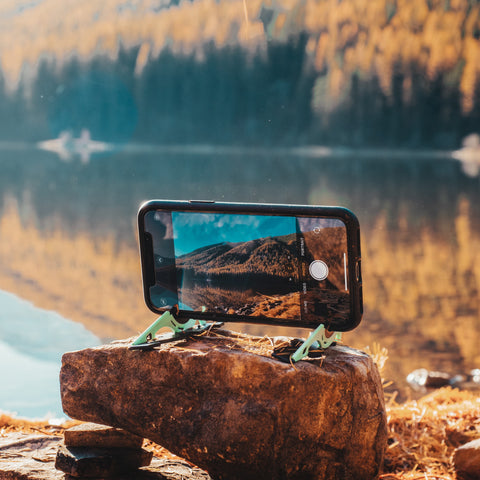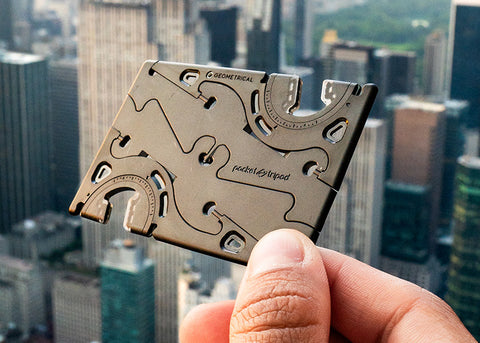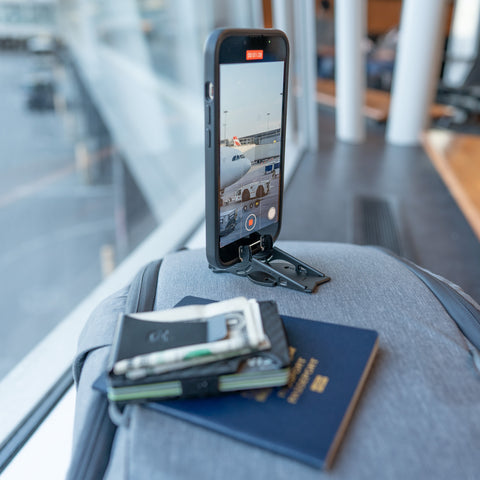
Do you see the world on a grand scale? Whether you take the road less taken or travel the well-trodden paths in your own region, you're sure to find moving viewpoints that will inspire your inner photographer. As long as you have your smartphone in your back pocket, professional-quality landscape photos are just a click away. Use this guide to capture your best landscapes.
Why a mobile phone is the perfect tool for landscape photography

From Apple iPhone to Samsung Galaxy to Google Pixel and beyond, the photos you can take from that little device can have the quality to rival shots taken with a high-end DSLR. Their wide lenses allow for incredible landscape photography, and their compact design means you don’t have to carry a heavy load on your trek to those remote vistas. Recent developments in smartphone technology have packed a load of power into the camera app on your smartphone of choice. Advanced settings give you the power to manipulate exposure and composition while you shoot. Then, you have editing tools to take those photos to the next level. With third-party editing apps for photos and videos, you don’t even need your computer to transform that raw material into professional quality content.
The best tips
Your smartphone camera is simple to use and offers much more than basic point-and-shoot capability. To get the best results from your smartphone, follow these tips.
Wait for golden hour

Sometimes called magic hour, golden hour describes the moment just after sunrise and just before sunset when the sun is at its lowest, casting an elegant, warm glow and long, dramatic shadows. If you can plan your photo sessions for these times of day, you’re likely to capture your landscapes at their finest. But be aware that, depending on where you are, that precious hour of golden light may last only a quarter of an hour. Don’t despair if your window of opportunity is narrow for that magical period of warm sunlight. The light just before sunrise and just after sunset, which photographers call the blue hour, offers an opportunity to capture your surroundings in cooler tones. It may allow you to shoot your landscape in a unique light that gives your photos an air of mystery or moodiness. Be careful not to get caught after dark in unfamiliar territory. If you do, the good news is your smartphone also has a flashlight
Add foreground detail

Have you ever felt that your photograph doesn’t do justice to the impressiveness of the view you see in real life? Without a sense of depth, that landscape photo may fall flat. Including a foreground feature in your photo’s composition gives the viewer a sense of intimacy and provides a point of connection to the larger scene. You can give your landscape photo more impact by including a detail that draws the eye or captures the imagination. Look for a landmark like a boulder, tree stump or abandoned fence post. A person or animal can also serve as a foreground feature, adding a personal touch and conveying a sense of scale.
Consider leading lines
Think of how the image of a country road wending its way into the distance inspires a sense of mystery and curiosity. Great landscape photographers use leading lines to give some direction to the composition of their photographs. These lines are created by features within the landscape that convey a sense of distance or depth. When you’re looking at the view you want to photograph, seek elements in the space that naturally draw the eye deeper into the scene. Look for features like a railway track, a road or a river that you can build your composition around.

Get low
You’ve seen many landscape photographs captured from a high vantage point, but don’t neglect the creative possibilities of shooting from the ground up. A landscape scene shot from a lower angle can provide a surprising perspective and give the viewer a new way of seeing a familiar sight. Your smartphone is the perfect tool for achieving this shot. Turn your smartphone camera upside down and lower it to the ground to shoot upward. In this position, your lens gets closer to the ground than any DSLR camera could achieve. The result is a dramatic landscape with remarkable depth.

Straighten the horizon
A skewed horizon line can give your photos a messy appearance or ruin the shot completely. Use the gridlines on your camera screen to help you capture a straight horizon. If you have an iPhone, you can turn on the grid setting to help you align your shot as you take it. If your phone’s camera doesn’t have that option, you can use a grid in the editing function and rotate the photo after you’ve taken it. The added benefit of gridlines is that it also helps you compose your photo better. In this example we're framing the subject following the rule of thirds.

Don’t use zoom
Does your landscape have a delightful little detail just begging for a close-up? The zoom function on your phone’s camera is easy to use, but beware. It renders a low-resolution, highly pixelated image that won’t come anywhere near the image quality you expect. You’ll achieve better results if you take the shot at a wider angle and zoom in on that detail during editing.
Shoot for the highlights
The brightest points in your image are the highlights. When shooting your landscape, pay attention to those bright spots so that they don’t overpower the subtle details. If you’re facing the sun when taking your shot, your final image will likely include a striking solar flare. If you notice your camera shifting between exposure settings as it tries to adjust to the light, your exposure lock feature will let you hold the exposure setting you like. Even if you’re not looking for such a spectacular light effect, the night mode on your smartphone can take multiple photos in succession. Then, combine the images to achieve the best combination of shadows and light.
Be creative

When you’re looking at a breathtaking view, you may be tempted to let the landscape speak for itself. Rather than snapping a few shots and moving on, take some time to imagine how you might use the various features on your phone to create something unique.
- Time lapse. An ideal way to capture the dynamic nature of your landscape, your phone’s time lapse function enables you to capture gradual changes like the movement of the sun, clouds and shadows dance across the mountainside or the traffic variations on a cityscape. Switch your camera setting to Video, then select the option for time lapse.
- Exposure adjustments. Adjusting your exposure settings can ensure your photo captures colors the way you experience them in real life. The exposure settings will look different depending on the type of smartphone you have. If you have an iPhone, look for a sunburst image on your camera screen. On a Samsung, the exposure settings are activated by touching a light bulb icon.
- Long exposures. If you have an iPhone, you can use the Live Photos feature to achieve the effect of a long exposure. Select a Live Photos image and swipe up to get the Effects menu, then select Long Exposure.
- Use the rule of thirds. In photography, the rule of thirds refers to the added impact achieved when the photographic subject is located not in the center of the composition but at a one-third point. Your gridlines will mark out the thirds on your image, so keep the object of interest at the intersection of these lines for a striking effect.
- Blur and vignette. If there’s a specific feature in your landscape that you want to stand out, consider using a blur or vignette treatment to make it stand out. If your focus object is close enough, you may be able to achieve the effect while photographing it using the portrait setting on your camera. For landscapes, though, you may achieve better results at the photo editing stage. Take your time while shooting and experiment with a variety of different settings. One inspiring view can produce multiple masterpieces if you indulge your creativity.
Get a landscape tripod you can carry everywhere

Whether you’re taking still shots or videos, keeping your camera stable is crucial to getting it right. Still photography requires camera stability for long exposures and consistent composition over multiple shots. And when extra stability on precarious surfaces is needed, the tripod legs are designed to split apart and adjust independently to give you the perfect support to shot from any location! This landscape tripod does much more than keep your videos steady.

is the most compact, stable and versatile solution for smartphone photographers. This ingenious gadget is small enough to fit in your wallet and is extremely lightweight. You can take it with you on all your most daringexcursions, regardless of your weight limit. This travel tripod weighs just 0.4 ounces - not noticeable in a wallet.
With its ability to tilt to different angles and positions, you can shoot different landscape perspectives and use your creativity to create unique content. For example, try capturing a landscape from a low angle to emphasize the foreground and create a dramatic effect. The possibilities to explore your creativity is limitless!
Also, if you want to put yourself in the scene in your photos without falling into ordinary selfie compositions, all you have to do is find a good spot to put your tripod and capture photos with the shutter timer feature or Bluetooth remote control.
Edit your landscape content with an app
Not only can you capture excellent landscape photos with your smartphone, but you can also edit those photographs on your phone. The camera itself will have a suite of built-in editing functions, and your social media platforms also have standard photo-enhancing features.
Photo editing apps
You could use your computer to edit your photos professionally, but you don’t need it. Experiment with these mobile apps to take your photo editing to the next level directly on your smartphone:
- Adobe Lightroom Mobile enables editing on the go, with light adjustments for exposure, shadows and whites. Its color-enhancing options include temp, tint and vibrance settings. The Healing Brush tool allows you to remove distracting elements from your image. It boasts over 150 free and premium presets.
- VSCO describes itself as a desktop-quality photo in an app. Among its 200 presets is the Artificial Light AL3, a popular choice for both indoor and outdoor photography. The VSCO Spaces community enables users to engage with one another, sharing support and creativity.
- Snapseed has long been a popular choice for amateur Instagrammers wanting to level up their photo game. Its intuitive interface makes it easy to learn, and it offers a wide range of editing tools, plus automatic correction and enhancement options.
Video editing apps
A landscape is most often regarded as a still scene. But with creativity and the right tools, you could turn that beautiful scene into dynamic, compelling video content. If you’re interested in creating videos, explore these apps for video editing:
- CapCut offers high-efficiency video editing with tools for blurring, resizing and text/speech conversions. It also offers a library of commercial resources, including music, stickers, filters and effects.
- InShot is an easy-to-use app that lets you trim and split videos, merge clips and adjust speed. You can add transition effects to build a sophisticated video collage and add music from its vlog music library. It can be frustrating to say, “It was so much more beautiful in real life.” With just your smartphone and some skillful editing, your landscape shots will be just as spectacular as the real thing.
A high-performance tripod for your landscape photography
With your smartphone delivering premium-quality landscape photographs, the Pocket Tripod Pro offers an incredible range of perspectives. It has 180 degrees of tilt angle adjustment and has interchangeable adapters to accommodate any phone. Add the Bluetooth shutter remote, and you won’t even need to touch your camera to get the shot you want. Visit the Pocket Tripod shop and see for yourself how this tiny gadget can elevate your landscape photography game.


